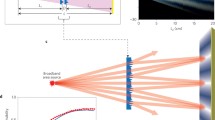Abstract
Some years ago, isodensitometry was introduced into the moiré technique in order to improve the sensitivity of this method. The application of the Sabattier effect gives now a new possibility to produce more lines of equal displacement. The obtained experimental data are the additional lines and the moiré fringes of full or half order. This method is applied on a beam under pure bending and a circular ring loaded diametrically. It will be shown in this paper that the calibration of the displacement curves can be accomplished by a calibration bar or by ‘self calibration’ which will be done on the same model to be studied. Further, the photographic process can be influenced in a way that different lines of equal displacement can be produced for a given system of moiré fringes. The additional lines are shifted here by choosing different times of exposure.
Similar content being viewed by others
References
Schwieger, H. andHaberland, G., “Die Anwendung der Äquidensitometrie in der Spannungsoptik,”Wiss. Z. Universität Halle-Wittenberg, Math. Nat.,4,853–858 (1955)and Feingerätetechnik,5,63–67 (1956).
Schwieger, H. andHaberland, G., “Die photographische Darstellung von Schubgleichen unterhalb der 1. Isochromatenordnung bei spannungsoptischen Versuchen,”Z. Angew. Phys.,8,350–355 (1956).
Schweiger, H. and Spuida, Chr., “Die Äquidensitometrie in der Kurzzeitphotographie am Beispiel des elastischen Randstosses auf eine Kreisringscheibe,” VII. Intern. Congress on High Speed Photography, Zürich (1965).
Lau, E. andKrug, W., “Die Äquidensitometrie,”Akad.-Verlag, Berlin (1957).
Krug, W. andWeide, H. G., “Wissenschaftliche Photographie in der Anwendung,”Akad. Verlagsgesellschaft Geest und Portig K. G., Leipzig (1972).
Thadani, B. N., “Improving Fringe Definition by Pseudosolarization,”Experimental Mechanics,12,423–425 (Sept.1972).
Chiang, F. P. andKhetan, R. P., “A New Method to Increase the Sensitivity of Photoelasticity,”Experimental Mechanics,14,29–32 (1974).
Durelli, A. J. andParks, V. J., Moiré Analysis of Strain, Prentice-Hall Inc., New Jersey (1970).
Theocaris, P. S., Moiré Fringes in Strain Analysis, Pergamon Press, New York (1969).
Ullman, K., “Anwendung des Moiréeffektes zur experimentellen Dehnungsanalyse Beiträge zur Spannungs und Dehnungsanalyse VI, Akad.-Verlag, Berlin (1970).
Sciammarella, C. A., “Moiré-fringe Multiplication by Means of Filtering and a Wave-front Reconstruction Process,”Experimental Mechanics,9,179–185 (1969).
Post, D., “Sharpening and Multiplication of Moiré Fringes,”Experimental Mechanics,7,154–159 (1967).
Sciammarella, C. A. andSturgeon, D., “Digital-filtering Techniques Applied to the Interpolation of Moiré-fringes Data,”Experimental Mechanics,7,468–475 (1967).
Post, D., “New Optical Methods of Moiré-fringe Multiplication,”Experimental Mechanics,8,63–68 (1968).
Chiang, F. P., “Techniques of Optical Filtering Applied to the Processing of Moiré-fringe Patterns,” State University of New York at Stony Brook, Report No. 122 (1968).
Sciammarella, C. A., “Techniques of Fringe Interpolation in Moiré Patterns,” II. Intl. Cong. on Exp. Mech., Washington (1965).
Theocaris, P. S., “The Formation, Retrieval and Multiplication of the Moiré Signal,”Materialprüf.,11,11–19 (1969).
Sciammarella, C. A., “Basic Optical Law in the Interpretation of Moiré Patterns Applied to the Analysis of Strains,”Experimental Mechanics,5,154–160 (1965).
Ross, B. E., Sciammarella, C. A. andSturgeon, D., “Basic Optical Law in the Interpretation of Moiré Patterns Applied to the Analysis of Strains,”Experimental Mechanics,5,161–166 (1965).
Högner, W., “Der Sabattier-Effekt als hervorragendes Hilfsmittel in der Äquidensitometrie,”Fotografie,17,457 (1963).
Högner, W., “Die Herstellungstechnik photographischer Äquidensiten,”Jenaer Rundschau,14,340 (1969).
Friedrich, G., “The Equidensity Film in the Field of Photoelasticity,”Mechanics Research Communications,1,79–84 (1974).
Arens, H., “Über die Theorie des Sabattiereffektes,”Z. Wiss. Photograph.,44,44,51, 172 (1949),Z. Wiss Photograph.,45,1 (1950).
Mees, C. E. Kenneth andJames, T. H., The Theory of the Photographic Process, Macmillan Comp., New York (1966).
Author information
Authors and Affiliations
Rights and permissions
About this article
Cite this article
Schwieger, H., Plath, H.H. A new application of isodensitometry in the moiré technique. Experimental Mechanics 16, 258–262 (1976). https://doi.org/10.1007/BF02321149
Received:
Revised:
Issue Date:
DOI: https://doi.org/10.1007/BF02321149




